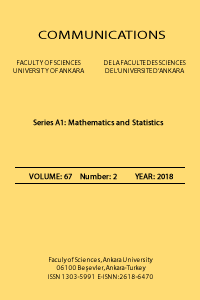Some numerical characteristics of direct sum of operators
The numerical range W(T) of a linear bounded operator T on a Hilbert space is the collection of complex numbers of the form (Tx,x) with x ranging over the unit vectors in the Hilbert space. In this study, firstly, the connection between numerical range of direct sum of operators in the direct sum of Hilbert spaces and their coordinate operators has been investigated. At the end of the first investigation the result obtained is as follows: If for any n≥1, H_{n} is a Hilbert space, A_{n}∈L(H_{n}), H=⊕_{n=1}^{∞}H_{n} and A=⊕_{n=1}^{∞}A_{n}, A ∈L(H), then numerical range of the operator A is in the form W(A)= co (⋃_{n=1}^{∞}W(A_{n}) ), where co (Ω), Ω⊂C denotes the convex hull of Ω. The numerical radius w(T) of a linear bounded operator T on a Hilbert space is a number which is given by w(T)=sup {|λ| : λ∈W(T) }. In this study, secondly, the connection between numerical radius of direct sum of operators in the direct sum of Hilbert spaces and their coordinate operators has been investigated. At the end of the second investigation the result obtained is as follows: If for any n≥1, H_{n} is a Hilbert space, A_{n}∈L(H_{n}), H=⊕_{n=1}^{∞}H_{n} and A=⊕_{n=1}^{∞}A_{n}, A ∈L(H), then numerical radius of the operator A is in the following form w(A)= sup w(A_{n}). The Crawford number c(T) of a linear bounded operator T on a Hilbert space is given by c(T)=inf {|λ| : λ∈W(T) }. In this study, thirdly, the connection between Crawford number of direct sum of operators in the direct sum of Hilbert spaces and their coordinate operators has been investigated. At the end of the third investigation the result obtained is as follows: If for any n≥1, H_{n} is a Hilbert space, A_{n}∈L(H_{n}), Re(A_{n})≥0 (≤0), H=⊕_{n=1}^{∞}H_{n} and A=⊕_{n=1}^{∞}A_{n}, A ∈L(H), then Crawford number of the operator A is in the following form c(A)=inf c(A_{n}). Moreover, It is known that for a linear bounded accretive operator T if W(T)⊂{z ∈C:|argz| < ϕ} for any ϕ∈[0, π/ 2), then it is called a sectorial operator with vertex γ=0 and semi-angle ϕ. In this case, T ∈S_{ϕ}(H). In this study, finally, the connection between sectoriality of direct sum of operators in the direct sum of Hilbert spaces and their coordinate operators has been investigated. At the end of the last investigation the result obtained is as follows: If for any n≥1,H_{n} is a Hilbert space, A_{n}∈L(H_{n}),A_{n}∈S_{ϕ_{n}}(H_{n}),H=⊕_{n=1}^{∞}H_{n} and A=⊕_{n=1}^{∞}A_{n},A∈L(H), then for some ϕ∈[0,π/2), A∈S_{ϕ}(H) the necessary and sufficient condition is sup ϕ_{n}<ϕ. At the end of this study, an example including all these connections has been given.
___
- Gustafson, K.E., Rao, D.K.M., Numerical Range: The Field of Values of Linear Operators and Matrices, Springer, New York, 1997.
- Halmos, P., A Hilbert Space Problem Book (sec. ed.), Springer-Verlag, New York, 1974.
- Bonsall, F.F., Duncan, J., Studies in Functional Analysis-Numerical Ranges, Stud. Math., vol.21, Mathematical Association of America, 1980.
- Kato, T., Perturbation Theory for Linear Operators, Springer-Verlag, New York, 1980.
- Shapiro, J.H., Lecture Notes, Notes on the Numerical Range, 2003.
- Goldberg, M., Tadmor, E., On the Numerical Radius and Its Applications, Linear Algebra and Its Applications, 42 (1982), 263-284.
- Ando, T., Li, C. K., The Numerical Range and Numerical Radius, Special Issue, Linear and Multilinear Algebra 37 (1994), 1-238.
- Dunford, N., Schwartz, J. T., Linear Operators I; II, Second ed., Interscience Publishers, New York, 1958; 1963.
- Ismailov, Z.I., Multipoint Normal Differential Operators for First Order, Opusc. Math. 29 (4) (2009), 399-414.
- Kochubei, A. N., Symmetric Operators and Nonclassical Spectral Problems, Mat. Zametki 25 (3) (1979), 425-434.
- Zettl, A., Sturm-Liouville Theory, First ed., Amer. Math. Soc., USA, 2005.
